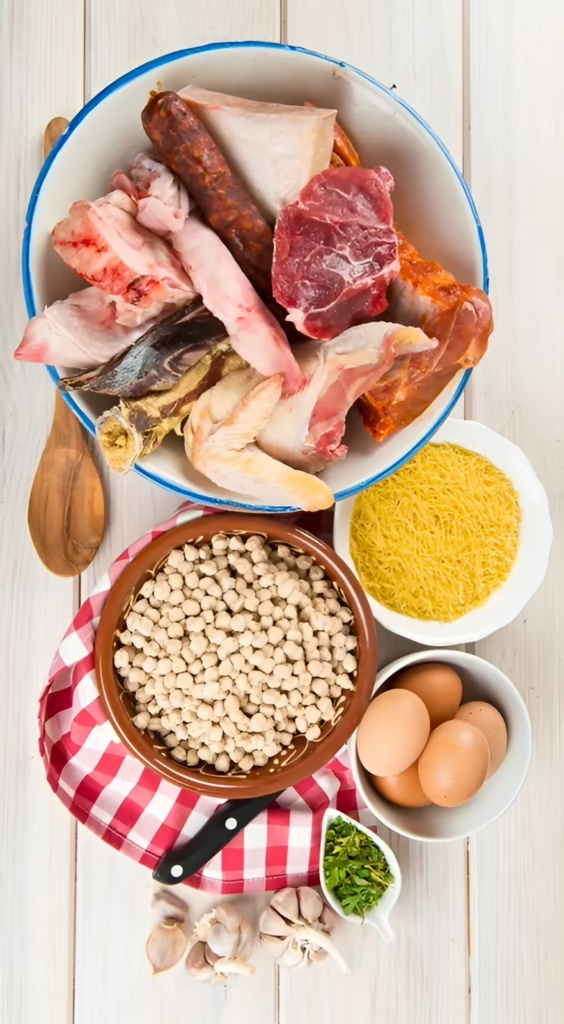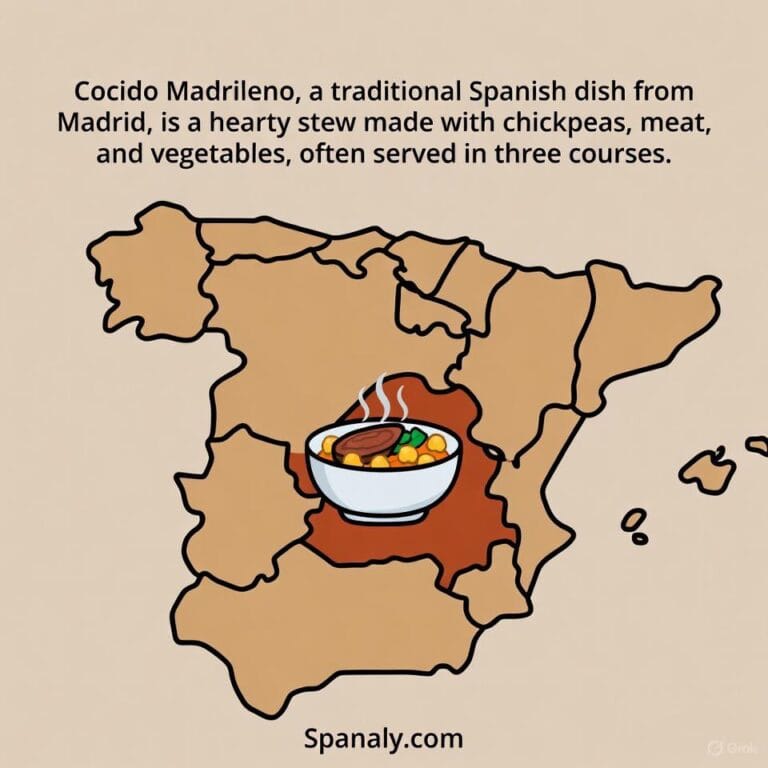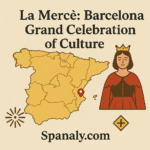Table of Contents
Toggle1. The Taste of Madrid’s Soul
As the city’s rhythm slows and the winter sun fades
behind Madrid’s terracotta rooftops, a comforting aroma begins to rise
from the kitchens and taverns — the unmistakable scent of Cocido
Madrileño. (To discover all the must-try cultural and culinary spots on
your visit, see our comprehensive Madrid travel planning guide.) This
traditional chickpea stew is far more than a meal; it’s a ritual, a
memory, and a symbol of Madrid’s identity. Every spoonful carries
centuries of warmth and history. Once a humble dish that sustained
farmers and travelers, today it graces both family tables and
Michelin-starred restaurants. Through changing times, one thing remains:
Cocido’s power to bring people together. As locals say, “If you want to
understand Madrid, start with its cocido”
2. The Origins: From Humble Roots to a City Symbol
Cocido Madrileño’s story traces back to medieval Spain, evolving from the rustic olla podrida, a slow-cooked stew that symbolized nourishment and community. Its base — chickpeas, meat, and vegetables — reflected the modest diet of rural Castile.
Some culinary historians link it to Sephardic Jewish cooking, where chickpea stews were common long before pork became part of the recipe. Over time, Christian, Muslim, and Jewish influences merged in Madrid’s kitchens, creating a dish layered with history and flavor.
By the 18th century, Cocido had become a staple across all social classes — served in royal dining rooms and humble taverns alike. In the 19th century, foreign travelers described it as “the city’s edible portrait,” a meal that captured Madrid’s warmth, resilience, and spirit of equality
3. Ingredients and the Ritual of “Tres Vuelcos”

Cocido Madrileño is not served all at once but in three separate courses, known as “los tres vuelcos” — literally, “the three turnings.” Each stage represents abundance born from simplicity and patience.
First Vuelco – The Soup:
A clear, golden broth infused with all the stew’s essence. Served with thin noodles (fideos), it’s light and fragrant — the perfect opening note.
Second Vuelco – The Vegetables and Chickpeas:
Tender chickpeas mingle with cabbage, carrots, and potatoes, their flavors harmonized by hours of slow simmering alongside meats and bones.
Third Vuelco – The Meats:
The grand finale — beef shank, chicken, chorizo, morcilla (blood sausage), and pork belly, offering richness, depth, and comfort in every bite.
Traditionally cooked in clay pots for several hours, Cocido was once a Sunday family ritual. Even today, in old Madrid taverns, the slow bubbling of cocido on the stove remains a sacred sound
4. A Cultural Icon of Madrid
For Madrileños, Cocido is memory made edible. It embodies “slow living” in a fast-paced capital. On Sundays, families gather for long, unhurried lunches where stories flow as freely as the wine.
Cocido appears often in literature and art as a metaphor for hospitality and endurance. During wars and hard times, it symbolized solidarity — a meal meant to be shared. After Spain’s civil war, it became a humble yet hopeful reminder of survival.
Even now, traditional eateries dedicate specific days — often Wednesdays or Thursdays — as “Cocido Day.” The city even celebrates an annual Ruta del Cocido Madrileño, where restaurants compete to serve the most authentic or innovative version
5. Where to Taste the Best Cocido in Madrid
If you wish to experience Cocido like a true Madrileño, a few legendary spots are a must:
La Bola Taberna (since 1870): Each cocido portion is cooked in individual clay pots over charcoal. Rich, smoky, unforgettable.
Lhardy (founded in 1839): Elegant and historic, this is where Madrid’s elite once savored their cocido in crystal dining rooms.
Malacatín: Near La Latina district, this old tavern serves famously huge portions and traditional flavors that haven’t changed in a century.
Casa Carola: Beloved for its all-you-can-eat cocido and lively atmosphere — a true feast for both heart and stomach.
DiverXO (modern take): Chef Dabiz Muñoz has reimagined cocido into an avant-garde tasting experience, honoring the classic through innovation.
Wherever you go, one thing is certain: cocido tastes best when shared
6. How to Make It at Home: The Authentic Recipe
Serves 6 | Cooking time: 3–4 hours
Ingredients:
500 g dried chickpeas (soaked overnight)
300 g beef shank
150 g pork belly
1 ham bone (optional, for depth)
1 chorizo sausage
1 morcilla (blood sausage)
1 chicken leg or thigh
1 cabbage, 2 carrots, 2 potatoes
Olive oil, salt
Thin noodles (for the soup)
Preparation:
In a large pot, add meats and cover with cold water. Bring to a boil and skim impurities.
Add chickpeas and reduce heat. Let simmer for about two hours.
Add vegetables and cook gently until everything is tender.
Strain the broth and cook noodles in it for the first serving.
Serve the meal in three courses — broth, vegetables, then meats.
Pro tip: The secret to an exceptional cocido lies in slow cooking and quality chickpeas — ideally from Fuentesaúco, a region known for its tender variety. Many Madrileños also prepare it one day ahead; the flavors deepen overnight
7. Modern Twists and Gourmet Evolutions
While tradition reigns supreme, Madrid’s chefs have reimagined Cocido Madrileño in creative ways. In fine-dining restaurants, you might find deconstructed versions, where each component is presented as an artistic expression.
Vegan and vegetarian versions replace meat with roasted mushrooms, smoked paprika, and olive oil broth, keeping the comforting spirit alive. Some chefs even serve the three vuelcos as tasting-menu courses, pairing each with a specific Spanish wine.
These modern interpretations celebrate the same principle that made Cocido timeless: transforming simple ingredients into deep, soulful flavors
8. Traveler Tips: How, When, and Where
🕛 Best time to eat: Lunch — it’s too hearty for dinner.
❄️ Best season: Autumn and winter, when Madrid’s chill invites warm dishes.
💶 Average price: €15–€30 per person, depending on the restaurant.
🍷 Drink pairing: Rioja red wine or tinto de verano.
🧭 Try a Cocido Route: Every February and March, local restaurants join the Ruta del Cocido Madrileño — a must for food lovers.
🗣️ Cultural tip: Locals often debate where the best cocido is served — it’s a conversation starter!
9. Cocido and Spanish Identity
Beyond Madrid, cocido has inspired countless regional versions — Cocido Maragato in León, Cocido Montañés in Cantabria — each reflecting local climates and customs. Yet Madrid’s version remains the most iconic, a unifying symbol of Spain’s culinary heart.
The dish captures Spain’s spirit of transformation: modest ingredients elevated through care, patience, and community. Like flamenco or bullfighting, it carries emotion, heritage, and rhythm — but in this case, it’s a rhythm of simmering pots and shared laughter
10: A Bowl of Warmth, Memory, and Madrid
Cocido Madrileño is more than a stew — it’s a story in three acts.
It begins with the gentle promise of broth, grows with the heartiness of chickpeas and vegetables, and ends with the bold embrace of meats and spices. Each spoonful is an echo of Madrid’s past: of farmers and kings, of winters endured and families gathered around wooden tables.
In a city known for its energy and art, Cocido Madrileño remains its quiet soul — timeless, generous, and deeply human.
If you ever find yourself wandering through Madrid on a chilly day, follow the aroma drifting from an old tavern. Inside, you’ll find not just food, but the essence of Spain served steaming hot


